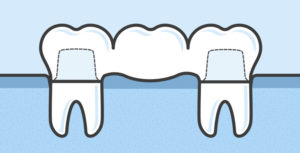
Are you missing one or more teeth and looking for a solution that can restore your smile and oral functionality? Dental bridges might be the answer you’ve been searching for. In this blog post, we’ll explore what dental bridges are, how they work, and whether they are the right choice for you.
Get ready to bridge the gap and rediscover your confident smile with this comprehensive guide to dental bridges.
What are dental bridges?
Dental bridges are prosthetic devices used to replace one or more missing teeth. They bridge the gap created by the missing teeth and are typically made up of one or more artificial teeth, known as pontics, that are supported by adjacent natural teeth or dental implants.
The pontics are custom-made to match the color, shape, and size of your natural teeth, ensuring a seamless and natural-looking smile. Dental bridges not only restore the appearance of your smile but also help improve chewing ability, maintain proper dental alignment, and prevent surrounding teeth from shifting.
They are a popular and effective solution for filling the gaps left by missing teeth, allowing you to enjoy a complete and functional set of teeth once again.
Benefits of dental bridges
Dental bridges offer numerous benefits for individuals with missing teeth. Here are some key advantages of dental bridges:
- Restored Smile: Dental bridges fill the gaps left by missing teeth, giving you a complete and aesthetically pleasing smile. They enhance your appearance and boost your self-confidence.
- Improved Chewing and Speaking: Missing teeth can make it challenging to eat certain foods and pronounce certain words. Dental bridges restore proper dental function, allowing you to chew and speak with ease and confidence.
- Enhanced Facial Structure: When teeth are missing, facial muscles can sag, leading to a sunken appearance. Dental bridges help maintain the natural shape of your face, preventing the sagging of facial muscles.
- Balanced Bite: Gaps caused by missing teeth can result in an uneven bite, leading to discomfort and potential jaw problems. Dental bridges restore the proper alignment of your teeth, improving your bite and reducing strain on the jaw joints.
Procedures of getting dental bridges
The process of getting dental bridges typically involves several steps, including:
- Initial Consultation: Schedule a consultation with your dentist to discuss your dental needs and determine if dental bridges are the right solution for you. During this visit, your dentist will examine your oral health, evaluate the condition of your remaining teeth, and discuss the treatment options available.
- Treatment Planning: If dental bridges are deemed suitable for your case, your dentist will develop a personalized treatment plan. This includes selecting the appropriate type of dental bridge, considering factors such as the location of the missing teeth, the condition of adjacent teeth, and your aesthetic preferences.
- Tooth Preparation: To ensure a secure and comfortable fit, the teeth adjacent to the gap will be prepared. This involves removing a thin layer of enamel from these teeth to make room for the dental crowns that will support the bridge. Your dentist will administer a local anesthetic to ensure a painless procedure.
- Impression Taking: After tooth preparation, your dentist will take impressions of your teeth. These impressions serve as a model for the dental laboratory to create a custom bridge that fits your mouth perfectly. You may be provided with a temporary bridge to wear while your permanent bridge is being fabricated.
- Bridge Placement: Once your custom bridge is ready, you will return to the dental office for the final bridge placement. Your dentist will remove the temporary bridge (if provided) and ensure that the permanent bridge fits properly. They will then use dental cement or adhesive to securely bond the bridge onto the prepared teeth or dental implants.
- Bite Adjustment and Polishing: After the bridge is in place, your dentist will check your bite to ensure proper alignment and make any necessary adjustments. They will also polish the bridge to give it a smooth and natural appearance.
- Follow-Up Care: Your dentist will provide instructions on how to care for your new dental bridge, including proper oral hygiene practices and dietary recommendations. It is important to attend regular dental check-ups to monitor the condition of your bridge and maintain your oral health.
Each individual case may have unique variations in the procedures involved, depending on the specific needs and conditions of the patient. Your dentist will guide you through the process, answering any questions you may have and ensuring that you are comfortable and well-informed throughout the treatment.
We hope you learn a thing or two in this article. Visit Dental Matters to learn more dental topics, tips, and treatments!






